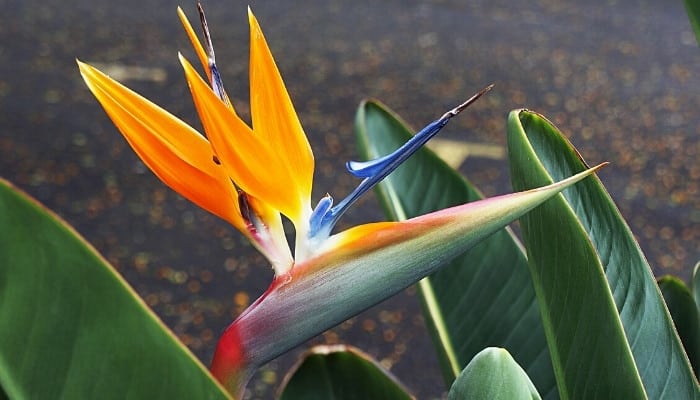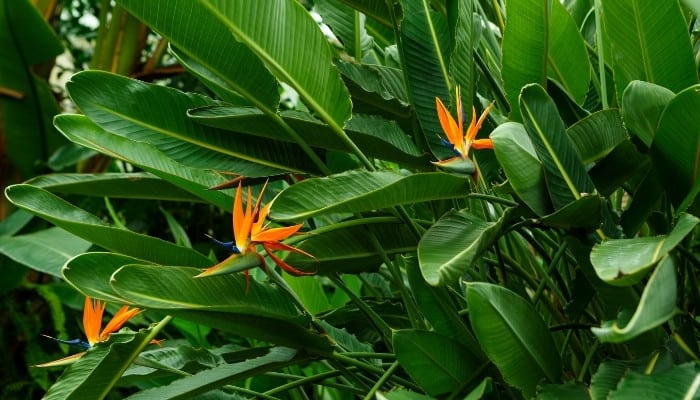If you are in search of a standout plant that can completely elevate a room, the bird of paradise is the perfect choice.
As a relative to the banana, the bird of paradise has large, waxy leaves that look great even when the decorative orange flowers aren’t blooming.
With a plant that can grow over 5 feet tall, you’ll want to keep it in tip-top shape since everyone will be seeing it.
Why are my bird of paradise leaves curling? The primary reasons for leaf curling on bird of paradise are insufficient water and lack of humidity. However, poor water or soil quality, cool temperatures, incorrect lighting, improper fertilization, pests, diseases, being rootbound, and transplant stress can cause leaves to curl as well.
Since there are so many factors that can be affecting the health and appearance of your bird of paradise leaves, read through this list to narrow down which issues you might be facing.
Simple solutions can help you get those leaves broad and showy once again.
Reasons for Bird of Paradise Leaves Curling
The health of the leaves is indicative of the overall health of the plant.
Not all bird of paradise plants will bloom indoors, but keeping the overall health of the plant intact is the first step to creating the flashy orange blooms.
1. Watering/Humidity Issues
The bird of paradise prefers to have soil that is slightly damp most of the time. It will not take well to drying out completely between waterings.
In addition, the large surface area on the leaves can make it easier for them to lose moisture, but high humidity can combat the water loss.
Solution
Maintain a regular watering schedule for your bird of paradise.
Water thoroughly when the top couple inches of soil are dry. Check the plant frequently until you have determined the appropriate watering schedule for your plant and environment.
Maintain high humidity by running a humidifier, misting the leaves two times per week, or setting up a pebble tray under the plant.
I recommend using this ultra-quiet humidifier with a rotating nozzle so that you can accurately direct the mist straight toward the plant.
2. Water Quality Issues
Depending on where you live, your tap water can contain different amounts of chemicals and trace minerals.
Sometimes these substances can be at levels that are detrimental to the health of your bird of paradise.
Solution
If you know you have particularly hard water or if you’d just like to be proactive, only use filtered water for your bird of paradise.
If you are concerned about chlorine in particular, you can let your watering can (filled with tap water) sit out overnight before watering. This removes a good amount of the chlorine.
3. Temperature Issues
The bird of paradise is a tropical plant that enjoys a warm environment between 65-85°F.
Solution
Maintain moderate to warm temperatures year round. In addition, do not plant the bird of paradise in a location that is too close to a heat source or an air conditioning vent.
4. Lighting Issues
Your bird of paradise will do well with very bright, indirect light or moderate amounts of direct sunlight. Not sure what exactly the difference is? We explain it all here.
However, it still has a “goldilocks” zone where too much direct sun can cause leaf burn and curling. On the other hand, too little light will cause the leaves to wilt and curl.
Solution
Find a location in your home where your bird of paradise receives bright, indirect light and/or some direct light.
However, the direct sunlight should not be the harsh midday sun that many climates receive during the summer months.
5. Soil Issues
Planting your bird of paradise in soil that has the correct nutrients, pH, and structure is extremely important to maintain bright, healthy leaves.
The bird of paradise is a heavy feeder, so it needs nutrient-rich, well-draining soil for optimal health.
However, over-fertilizing can burn the roots and poison the plant. The best soil will be slightly acidic, with a pH of 5.5-7.5.
Solution
To decrease the pH of your soil, add sulfur or peat moss to your mix.
If you believe you have over-fertilized your bird of paradise, remove and replace the top couple inches of soil.
Take your plant outside and thoroughly rinse the soil multiple times (allowing it to drain completely in between rinses).
For poor-quality soil, consider repotting your bird of paradise in fresh, quality potting soil (like this organic mix) or adding a couple inches of fresh soil to the pot.
6. Pest Issues
The bird of paradise can be infested by any of the common houseplant pests.
However, sap-sucking insects, like mealybugs, scales, mites, and thrips, will cause the most damage aesthetically to the leaves.
Solution
Check your plant regularly for any sign of pests. Treat the plant with an insecticidal soap or neem oil (I use this organic neem) at the first sign of any pests.
You can also treat the plant once every or every other month as a preventative.
7. Disease Issues
Since the bird of paradise enjoys moisture, there is always a chance that a fungal infection can take hold. This is commonly seen as root rot or leaf spot.
While root rot can often progress too far for the plant to be saved, leaf spot can typically be treated and contained.
Solution
If any parts of the plant are salvageable after root rot is discovered, they can be disinfected with diluted hydrogen peroxide and replanted into new soil and a new pot.
For leaf spot, treat the infected area with a copper-based fungicide.
8. Repotting Issues
Your bird of paradise will need to be repotted every couple of years (at minimum).
Pot bound roots that are housed in nutrient-depleted soil cannot effectively absorb and transport the water and resources the plant needs.
After repotting, your plant can sometimes suffer transfer shock, which can result in leaf curl as well.
Solution
Repot your bird of paradise if there are any signs of the plant being rootbound – roots coming out of the drainage holes or growing out of the top of the soil.
For transfer shock, try to disturb the plant as little as possible. Put it in the same location while maintaining the same watering and fertilizing schedules.
Even if the leaves curl after repotting, the plant should rebound within a couple of weeks.
Other Common Bird of Paradise Leaf Issues

Since the leaves on the bird of paradise are so large, any issues become apparent very quickly.
It is important to monitor your plant for these issues so steps can be taken to fix the problem as soon as possible.
Leaves Splitting
In nature, the leaves of the bird of paradise will naturally split due to animal activity and weather. This does not affect the health of the plant, but it can be less attractive in the home.
Solution
Do not leave your bird of paradise in a high-traffic location where it could be bumped.
Avoid any strong air drafts or heat sources that could rapidly dry out the leaves, and maintain high humidity.
Leaves Turning Yellow
The older/lower leaves are usually the first ones to turn yellow, which is a sign of imbalance. Most often, the issue is caused by overwatering or under-fertilizing the plant.
Solution
Only water your bird of paradise when the top couple inches of soil are dry. Fertilize regularly during the growing season because the bird of paradise is a heavy feeder.
Leaves Developing Brown Spots
Brown spots can be caused by a number of issues with your bird of paradise.
Some of the more common causes are too much direct sunlight, over-fertilization, fungal infection, and pest infestation.
Solution
Analyze your bird of paradise and your care routine to determine the cause of the brown spots; then you can treat the plant accordingly.
Leaves Not Opening
The three reasons your leaves may not be opening are not enough light, not enough water, and a pest infestation.
Solution
Move the plant to a location where it is receiving a full day of bright, indirect light or at least a couple of hours of direct sunlight.
Water thoroughly when the top 2 inches of soil are dry. Check the plant regularly for any pests and immediately treat any infestations.
Related Questions:
What Is the Best Fertilizer for Bird of Paradise?
Osmocote Smart-Release Plant Food will provide your bird of paradise all the nutrients it needs.
This solution feeds your plant for up to 6 months and will not burn the plant when used according to the directions.
Why Is My Bird of Paradise Leaning?
There is typically a health concern if your bird of paradise is leaning. This could be due to root rot or transplant shock.
In addition, the plant could be receiving unbalanced sun exposure or not enough water.
Conclusion
By providing your bird of paradise with great care, you can undoubtedly prevent the broad, beautiful leaves from curling.
The above information can help you troubleshoot if you ever do run into curling leaves, though.

